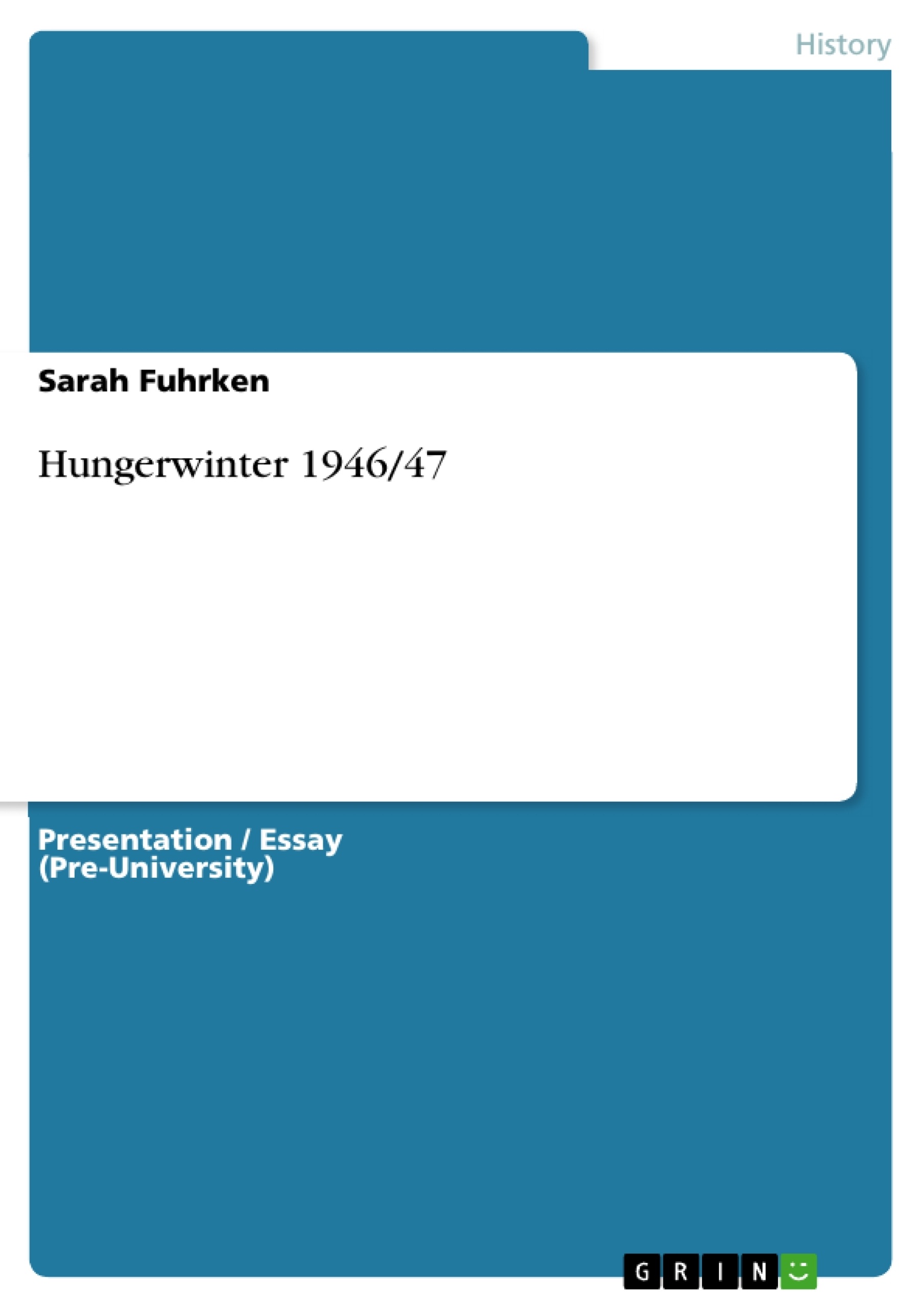This is a research paper about the hungerwinter in postwar Germany. It includes quotes from whitnesses and very reliable sources as well as a detailled report on the victims and other data.
OUTLINE
1. Introduction
2. Aftermath of World War II
3. Homes
4. Weather:
A. Hot summer
B. November
C. December
D. Impacts
E. January
5. Food
A. Facts
B. Impact on people
C. Begging
D. Ration Cards
6. Thefts
7. Günther Kammeyer
A. Experiences
B. New Life
8. End and Aftermath
9. Statement
10. Conclusion
HUNGERWINTER 1946/47
After World War II, another unexpected catastrophe was coming to Europe, especially to weak Germany: The Hungerwinter 1946/47. Right after the war had ended, the worst winter of the 20th century was hitting the destroyed cities and hungry people of Germany. Often called murderous, a disaster and horrifying, the hungerwinter took over 500 000 German lives.
1946: 12 years of national socialist regime bring 55 million deaths. It is the first peaceful year after, and the people are still weakened from poverty and hunger World War II brought. The loss of people means lack of workers in German factories, so most productions stopped and the infrastructure is completely destroyed. Moreover, the Allies destroyed most functioning machines and their newly installed administrations in the four zones are still inexperienced. Plus, 40% of all the streets and tracks in Germany are destroyed.
The worst, however, is that most people have to live in destroyed cities. Nearly 25% of all homes are destroyed; most major cities have less than 50% undestroyed. But the people find a way, as for example Inge Kotsch: “Life had to go on, there was no time for grief.” Over 20 million people live in ruins, with bad or even nonexistent isolation. Moreover, 10 million people from East Europe are floating the country, searching for new homes. Yet, nobody knows, that the most brutal winter of the 20th century is lying right in front of them.
The summer 1946 was really hot, and a lot of the harvest has been destroyed by the sun. As the winter was coming over Europe, nobody was prepared nor had expected it to be that cold. The first “wave” hit in November and destroyed the last potatoes and other vegetable. It was an unusual cold that early, and together with the bad housing and shortness of food, people all over Europe were struggling to survive. However, the Soviet Union had the hardest time.
All in all, over 2 million people died between 1946 and 1947. When the second wave hits in December, the most important German rivers freeze completely, and with that the Germans loose an important food and coal source: shipping is impossible. The Rhine is frozen more than 60 kilometers long (ca. 37 miles) and the Elbe is frozen completely. With the cold come illnesses like scabies, hunger edema and frostbite. Tuberculosis and other milder illnesses become deathly. A lot of people don’t survive the so called “white death” (cold) and “black hunger”. The magazine TV Movie describes the hungerwinter as a “disaster” and “more terrible than anything we go through now”. The Allies are standing in front of a huge problem: How shall they bring the Germans through the coming winter? In January, the worst of the three big “cold waves” hits the Germans even harder. Edith Eints recalls: “The cold was so bad. Sometimes three people would sleep in one small bed to stay at least a bit warm.” But even that did not always protect them from the murderous cold.
Food was a big issue, too. As short as the resources had been after the war, during the big cold it just got worse. Instead of 2400 to 3000 calories a day, who were required, people got only about 800 calories. Only 5.5 grams of meat and fat per day were affordable. However, the people never lost their hope. Lotte Szelski, 90 years old, said: “This winter was the happiest, but also the saddest of my whole life. “ She was pregnant, even got her baby during the coldest days, and that without a home. However, she and her family survived. They spent their day worrying about how to get enough food for the next meal; they waited hours, just to get a small slice of bread. “Hunger is really bad, hunger hurts. Our meal would be a thin slice of bread and a slice of rutabaga.” As Edith Eints said, most people lived with the death right in front of them: “Hunger is fear. Fear what the next day brings, whether you or your family survive the night or whether it all ends in the morning. And the quality of food gets worse and worse. People often go begging. Although hunger hurts, so does begging. Often, the begging kids were treated like dogs, or beaten with sticks, as Martin Schneider recalls in the following story: Him and his brother were going out to farms to beg for food, because the ration cards were not enough to feed the whole family.
[...]
- Citar trabajo
- Sarah Fuhrken (Autor), 2011, Hungerwinter 1946/47, Múnich, GRIN Verlag, https://www.grin.com/document/205235
-

-

-

-
¡Carge sus propios textos! Gane dinero y un iPhone X. -

-
¡Carge sus propios textos! Gane dinero y un iPhone X. -

-
¡Carge sus propios textos! Gane dinero y un iPhone X. -

-
¡Carge sus propios textos! Gane dinero y un iPhone X. -

-
¡Carge sus propios textos! Gane dinero y un iPhone X.

